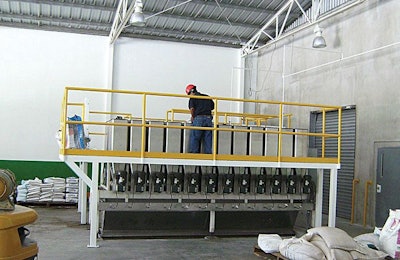
In an age of regulations, recalls and viral negative publicity, livestock feed producers can rely on some manufacturing equipment to assist in building consumer confidence by ensuring the mill produces safe and nutritious feed. Micro-ingredient systems (MIS), or the weighing and dosing component of an automated batching system, can do just that.
“Feed producers can show the consumer that they go to great lengths to make sure formulas are being precisely made,” says Terry Stemler, president, APEC USA. MIS "can show that they have genuine concern for the safety of their products by putting checks and balances in place.”
In automated feed mills, the utilization of MIS, or micro skids, allow feed producers to capture, track and trace the feed additives, vitamins, trace minerals and medications making their way through the plant. In the United States, for example, roughly 75 percent of animal feed manufacturers use MIS in their operations.
However, many smaller feed producers in developed and emerging markets continue to weigh their micro ingredients manually.
Beyond the labor and efficiency savings an MIS delivers, eliminating the liability of operator error provides an added assurance the feed has been safely and accurately produced.
“Micro systems provide accuracy and reduce the human error element that can occur when hand-adding ingredients,” says Steve Buehne, sales engineer, CPM Beta Raven. “The micro system, along with integrated lot tracking in the batching control system, provide traceable feed production.”
How MIS contribute to safe feed
Micro-ingredients play a crucial role in ensuring animal health and productivity, making the delivery method and its accuracy central to the success of the feed formulation.
“Micro-ingredient systems contribute to safe feed production by providing a precise dose of the ingredients, which are small part of the mix, but can have a big impact on the performance of the animal,” Stemler says. “They also help by providing a record of what was dosed and when.”
According to Sudenga’s Dale Winter, comparing “hand-add” dosing to a standard MIS, automated micro skids enhance feed safety in several ways:
1) Consistency: The ingredient weight will be the same in every batch.
2) Recordkeeping: Batch information is recorded automatically and electronically.
3) Technology: Devices, such as lid locks along with bar code scanners, prevent mistakes and track micro lot numbers as the feed is batched.
“The batching system directs the micro system to control auger speed based on its target size to attain maximum accuracy,” Buehne adds. “Any ingredient overages or shortages are recorded.”
In addition, batch automation systems gather ingredient data, such as time and date stamps of when ingredients are added to the mixer, which simplifies recordkeeping compliance for audits.
“In the case of medicated feed, accurate ingredient dosing is critical for FDA compliance,” Stemler notes. Maintaining "a record of the addition of drugs in some types of medicated feed is mandatory; it includes an inventory record of what went into the feed and what remains.”
He continues: “A properly sized micro-ingredient system helps resolve the potential hazard of an unintentional addition of too much or too little of a critical ingredient. It can also be an aid to preventing intentional adulteration of the feed by limiting the access points to introduce a material into the batch mixer.”
MIS essentials
Winter suggests feed mills looking to invest in an MIS or upgrade an existing unit make sure the machinery has the “ability to provide ingredient traceability and accurate ingredient scaling.”
The MIS suppliers suggest potential buyers look for these essential features:
- Multiscale hopper design: A multiscale hopper design uses several scales (one scale per four bins), providing smaller, more accurate scale control. With the reduced size of the load cell, smaller hoppers increase the scale resolution and allows the weighing of multiple ingredients simultaneously.
- Inventory tracking: An ingredient tracking system uses the weight to measure micro-ingredient level in the various hoppers.
- Bin lid locks: Lid locks on each micro hopper require operators use a bar code scanner to scan bagged ingredients before the batching software will disengage the lid when paired with the correct micro-ingredient bin.
- NTEP certification: National Type Evaluation Program (NTEP)-approved devices have been tested and evaluated to meet all government standards and requirements.
- Durable construction: Stainless steel components can stand up to the wear of caustic ingredients.
- Easy cleaning: The ability to thoroughly clean the units helps reduce the risk of ingredient carryover.
As an added benefit, Stemler notes that MIS also improve employee well-being and safety by “greatly decreasing the employee’s exposure to potentially harmful materials/dust and reduce repetitive stress disorders, such as carpel tunnel syndrome, that can be caused by hand weighing.”

















